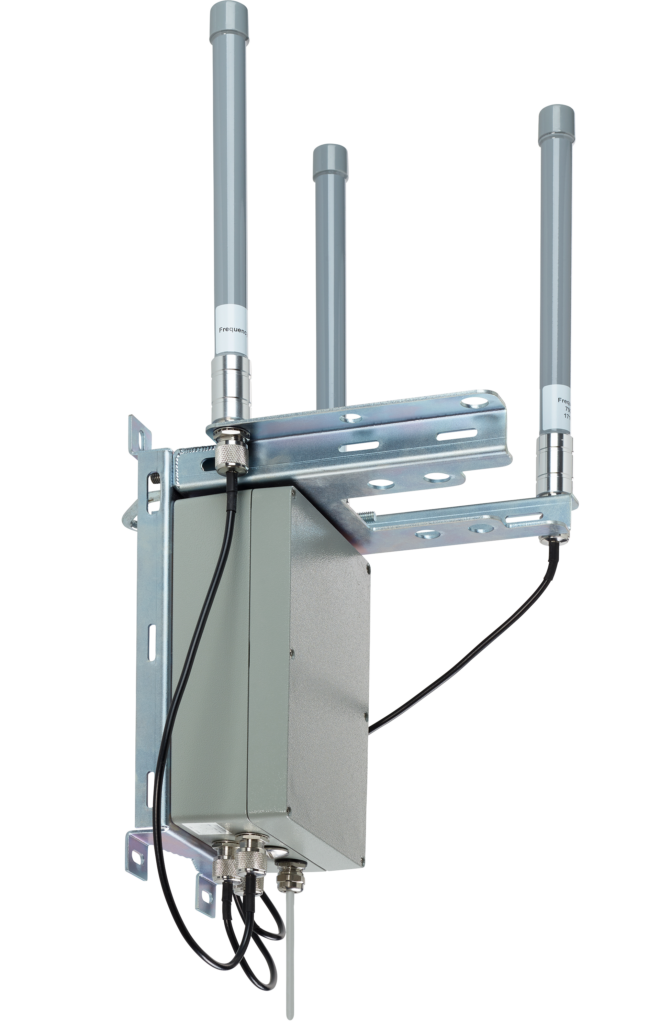
General questions
LoRaWAN® is a Low Power Wide Area Network (LPWAN) protocol that was specially developed for the communication of IoT devices. It enables energy-efficient and wireless data transmission over long distances.
This gateway has 16 channels. A 16-channel LoRaWAN® gateway can receive data via 16 frequency channels simultaneously, which means a higher capacity for the network and supports more devices.
More channels enable a higher data rate, minimise collisions and improve network performance, especially in densely populated areas with many IoT devices.
That depends on the region. In Europe, the 868 MHz band is common, while the 915 MHz band is used in the USA.
A 16-channel gateway can monitor twice as many frequencies simultaneously as an 8-channel gateway, which increases network coverage and efficiency.
Technical data
Configuration is carried out via the gateway’s web interface or SSH. Frequencies, network server details, APN and other parameters must be set there.
The standard channels in Europe are in the 868 MHz range: 868.1, 868.3 and 868.5 MHz, supplemented by additional optional channels.
By using two LoRa modems, each modem can be configured separately. This means that different LNS can also be entered.
Yes, the frequencies can be manually adjusted in the channel plan to meet the specific requirements of the network.
The range depends on the environment: In urban areas approx. 3-5 km, in rural areas up to 15 km.
A 16-channel gateway can support thousands of devices simultaneously, depending on the data rate and network traffic.
OpenWrt is a powerful open source Linux distribution that is particularly suitable for Internet of Things (IoT) gateways. It offers a high level of security thanks to regular security updates, supports a wide range of extensions and packages and offers many tutorials and documentation online thanks to a large community.
A 2G/3G/4G network is available as a backhaul option. Ethernet connection has priority by default; in the event of failure, the system automatically switches to the GSM network.
‘antenna_gain’ can be used to compensate the Tx output power “rf_power” of the gateway, namely by the gateway itself, not by the network server. In fact, the ‘rf_power’ field corresponds to the Tx LUT (Look Up Table) for each entry.
For example, the ‘rf_power’ together with its gain fields (‘pa_gain’, ‘mix_gain’ and ‘dig_gain’) may come from a generic/guided (i.e. without antenna) calibration performed at production time. You can therefore subsequently define the ‘antenna_gain’ in the ‘global_conf_chipX.json’ configuration file in order to take into account the gain of the antenna mounted on the gateway in the field.
In the packet_forwarder programme of the gateway, the ‘antenna_gain’ field is subtracted from the ‘rf_power’ field for all Tx-LUT entries as follows: final_rf_power = rf_power – antenna_gain. ‘antenna_gain’ must be a signed 8-bit integer ranging from -128 to +127.
Troubleshooting
Possible reasons are incorrect frequency settings, network server problems or too great a distance between the gateway and the device.
Reduce the transmission frequency of the devices or add another gateway to distribute the load.
Optimising the antenna position, using higher data rates and installing additional gateways can help.
Check the status of the gateway in the web interface or on the network server. The status is usually displayed in real time.
Advanced questions
LoRa is the physical transmission technology, while LoRaWAN® is a protocol that regulates network communication and management.
Yes, IoT gateway outdoor 16 can be integrated into private networks by connecting it to a local network server.
The gateway receives data from IoT devices and forwards it to the network server via Ethernet connection or GSM.
LoRaWAN® relies on BSI-compliant encryption. Data packets are encrypted using AES with key lengths of 128 bits. End-to-end encryption is used for the content, from the sensor to the LoRa network server. In addition, communication with the LNS is secured by a further 128-bit AES key. The use of this combination of AES cipher and 128-bit key length is recommended by the German Federal Office for Information Security in its TR-02102-1.





